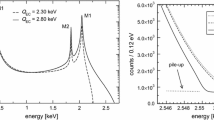Abstract
An experiment aimed at searches for an admixture of a sterile neutrino whosemass is 1 to 8 keV via detecting electrons from tritium decay in a proportional counter is proposed. The admixture in question can be discovered by a specific distortion of the energy spectrum of these electrons. For the above masses, the distortion extends over the whole spectrum; therefore, use can bemade of detectors that have a relatively low energy resolution (about 10 to 15%). A classic proportional counter is a simple and natural choice of detector for the decays of a gaseous tritium. The approach that we propose is novel in two respects. On one hand, the proportional counter used is made as a discrete unit in the form of a fully fused quartz tube. This permits a readout of current signals directly from the anode filament and ensures a high stability in the case of long-term measurements. At the same time, the application of state-of-the-art digital data-acquisition methods will make it possible to perform measurements under conditions of high counting rates—up to 106 Hz. As a result, the energy spectrum of electrons from tritium decays that is formed by 1012 counts could be accumulated within about a month. This data sample would make it possible to set an upper limit in the range of 10−3–10−5 on a sterile-neutrino admixture at a confidence level of three standard deviations (3σ) for m s in the range of 1–8 keV, this being one to two orders of magnitude more stringent than present-day limits.
Similar content being viewed by others
References
K. N. Abazajian et al., arXiv:1204.5379.
WMAP Collab. ( G. Hinshaw et al.), Astrophys. J. Suppl. 208, 19 (2013); arXiv:1212.5226.
Y. I. Izotov and T. X. Thuan, Astrophys. J. 710, L67 (2010); arXiv:1001.4440.
Planck Collab. (P. A. R. Ade et al.), arXiv:1303.5080.
M. Wyman et al., arXiv:1307.7715.
S. Dodelson and L.M. Widrow, Phys. Rev. Lett. 72, 17 (1994); hep-ph/9303287.
A. Boyarsky, O. Ruchayskiy, and M. Shaposhnikov, Annu. Rev. Nucl. Part. Sci. 59, 191 (2009); arXiv:0901.0011.
A. Boyarsky et al., Phys. Rev. Lett. 97, 261302 (2006); astro-ph/0603660.
J. J. Simpson, Phys. Rev. Lett. 54, 1891 (1985).
A. Hime and J. J. Simpson, Phys. Rev. D 39, 1837 (1989).
J. J. Simpson and A. Hime, Phys. Rev. D 39, 1825 (1989).
E. Holzschuh et al., Phys. Lett. B 451, 247 (1999).
M. Galeazzi et al., Phys. Rev. Lett. 86, 1978 (2001).
K.-H. Hiddemann et al., J. Phys. G 21, 639 (1995).
E. Holzschuh et al., Phys. Lett. B 482, 1 (2000).
K. Schreckenbach et al., Phys. Lett. B 129, 265 (1983).
M. M. Hindi et al., Phys. Rev. C 58, 2512 (1998).
M. Trinczek et al., Phys. Rev. Lett. 90, 012501 (2003).
J. Deutsch et al., Nucl. Phys. A 518, 149 (1990).
A. I. Belesev et al., JETP Lett. 97, 67 (2013); arXiv:1211.7193.
C. Kraus et al., Eur. Phys. J. C 73, 2323 (2013); arXiv:1210.4194.
M. Bahran and G. R. Kalbfleisch, Phys. Lett. B 291, 336 (1992).
M. Y. Bahran and G.R. Kalbfleisch, Phys. Lett. B 354, 481 (1995).
D. H.W. Kirkwood et al., Phys. Rev. 74, 497 (1948).
G. C. Hanna and B. Pontecorvo, Phys. Rev. 75, 983 (1949).
V. V. Kuz’minov et al., Prib. Tekh. Eksp., No. 4, 86 (1990).
S. Danshin et al., Nucl. Instrum. Methods Phys. Res. A 349, 466 (1994).
A. I. Berlev, Preprint No. 1189/2007, IYaI RAN (Inst. Nucl. Res., Moscow, 2007).
A. A. Alekseev, A. A. Bergman, L. I. Berlev, et al., Phys. At. Nucl. 73, 1487 (2010).
SAGE Collab. ( D. N. Abdurashitov, E. P. Veretenkin, V. M. Vermul, et al.) J. Exp. Theor. Phys. 95, 181 (2002).
V. I. Barsanov, Yu. I. Barsanov, A. A. Dzhanelidze, et al., Instrum. Exp. Tech. 49, 454 (2006).
R. E. Shrock, Phys. Lett. B 96, 159 (1980).
F. V. Tkachov, physics/0604127.
A. V. Lokhov, F. V. Tkachov, and P. S. Trukhanov, Nucl. Instrum. Methods Phys. Res. A 686, 162 (2012); arXiv:1111.4835.
D. N. Abdurashitov et al., Preprint No. 861/94, IYaI RAN (Inst. Nucl. Res., Moscow, 1994).
D. H. Wilkinson, Nucl. Phys. A 526, 131 (1991).
O. V. Kazachenko, private commun.
Author information
Authors and Affiliations
Corresponding author
Rights and permissions
About this article
Cite this article
Abdurashitov, D.N., Berlev, A.I., Likhovid, N.A. et al. Searches for a sterile-neutrino admixture in detecting tritium decays in a proportional counter: New possibilities. Phys. Atom. Nuclei 78, 268–280 (2015). https://doi.org/10.1134/S1063778815020027
Received:
Published:
Issue Date:
DOI: https://doi.org/10.1134/S1063778815020027




